COIT20248: Systems Analysis and Design Report for Charity Foundation
VerifiedAdded on 2023/06/09
|18
|2557
|333
Report
AI Summary
This report presents a detailed analysis of an information system project for the International Charity Foundation, developed in partnership with the Australian OAGDS organization. The report begins by outlining the need for automation to replace the current manual processes, aiming to reduce errors and complexity in managing child enrollment details. It explores various system development approaches, specifically advocating for the Waterfall model, and details the phases involved, including planning, analysis, design, implementation, and maintenance. The report then identifies both functional and non-functional system requirements, covering aspects such as data security and user interface design. A comprehensive cost-benefit analysis is provided, evaluating the project's economic benefits and costs over a five-year period, alongside a detailed project schedule using a Work Breakdown Structure and Gantt chart. The report concludes by discussing system information requirement investigation techniques, including stakeholder analysis and data gathering methods to ensure successful project implementation.
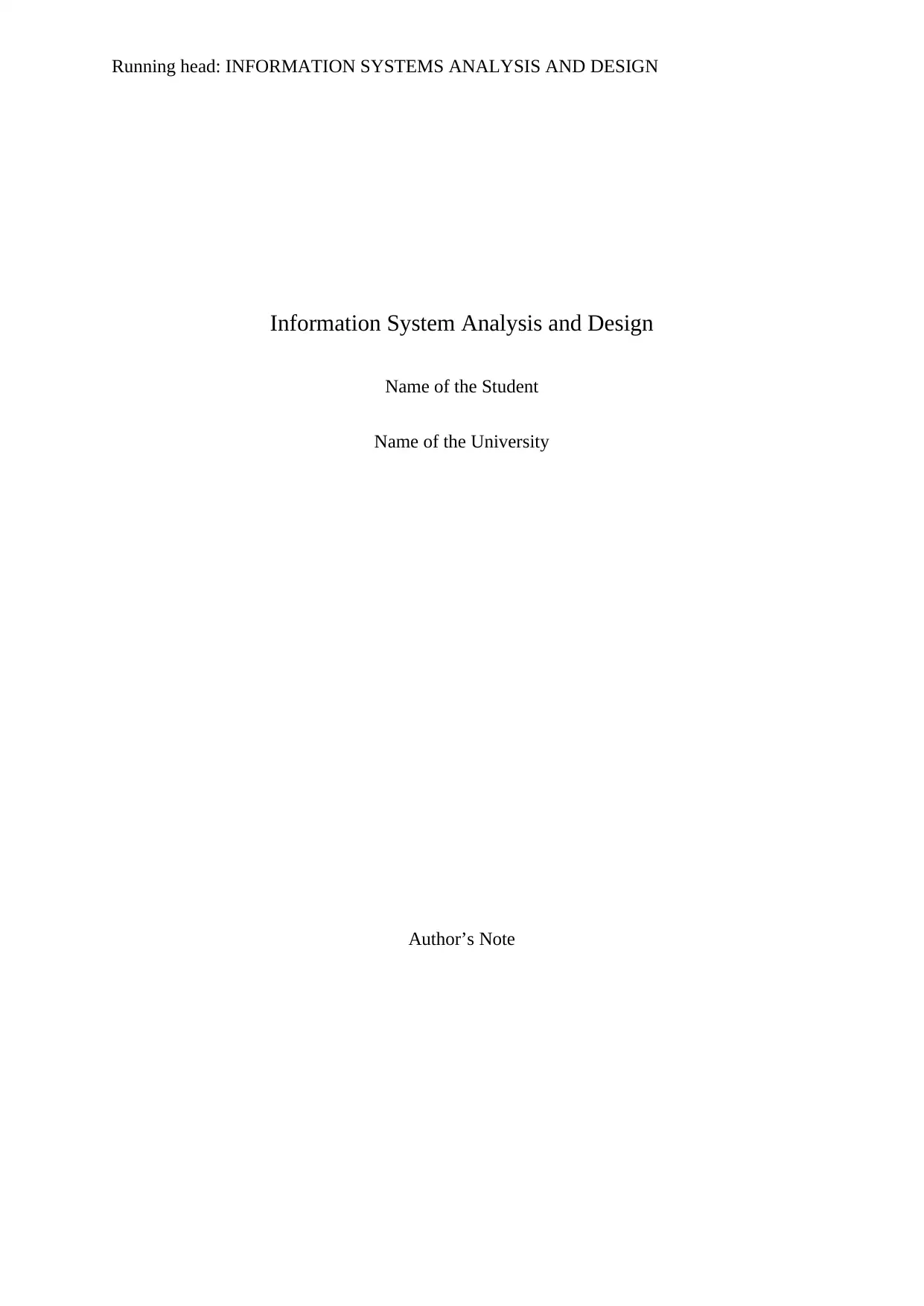
Running head: INFORMATION SYSTEMS ANALYSIS AND DESIGN
Information System Analysis and Design
Name of the Student
Name of the University
Author’s Note
Information System Analysis and Design
Name of the Student
Name of the University
Author’s Note
Paraphrase This Document
Need a fresh take? Get an instant paraphrase of this document with our AI Paraphraser
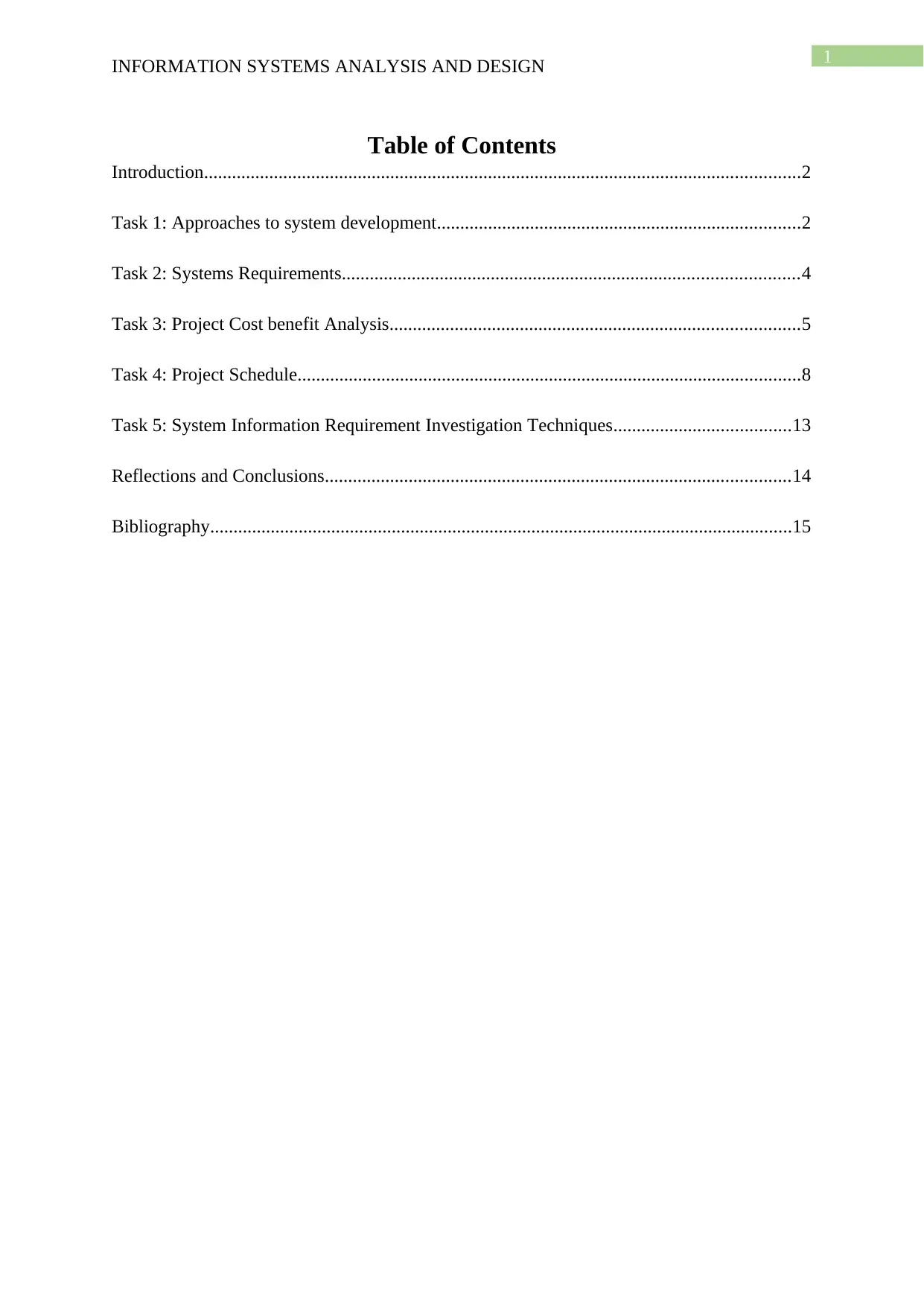
1
INFORMATION SYSTEMS ANALYSIS AND DESIGN
Table of Contents
Introduction................................................................................................................................2
Task 1: Approaches to system development..............................................................................2
Task 2: Systems Requirements..................................................................................................4
Task 3: Project Cost benefit Analysis........................................................................................5
Task 4: Project Schedule............................................................................................................8
Task 5: System Information Requirement Investigation Techniques......................................13
Reflections and Conclusions....................................................................................................14
Bibliography.............................................................................................................................15
INFORMATION SYSTEMS ANALYSIS AND DESIGN
Table of Contents
Introduction................................................................................................................................2
Task 1: Approaches to system development..............................................................................2
Task 2: Systems Requirements..................................................................................................4
Task 3: Project Cost benefit Analysis........................................................................................5
Task 4: Project Schedule............................................................................................................8
Task 5: System Information Requirement Investigation Techniques......................................13
Reflections and Conclusions....................................................................................................14
Bibliography.............................................................................................................................15
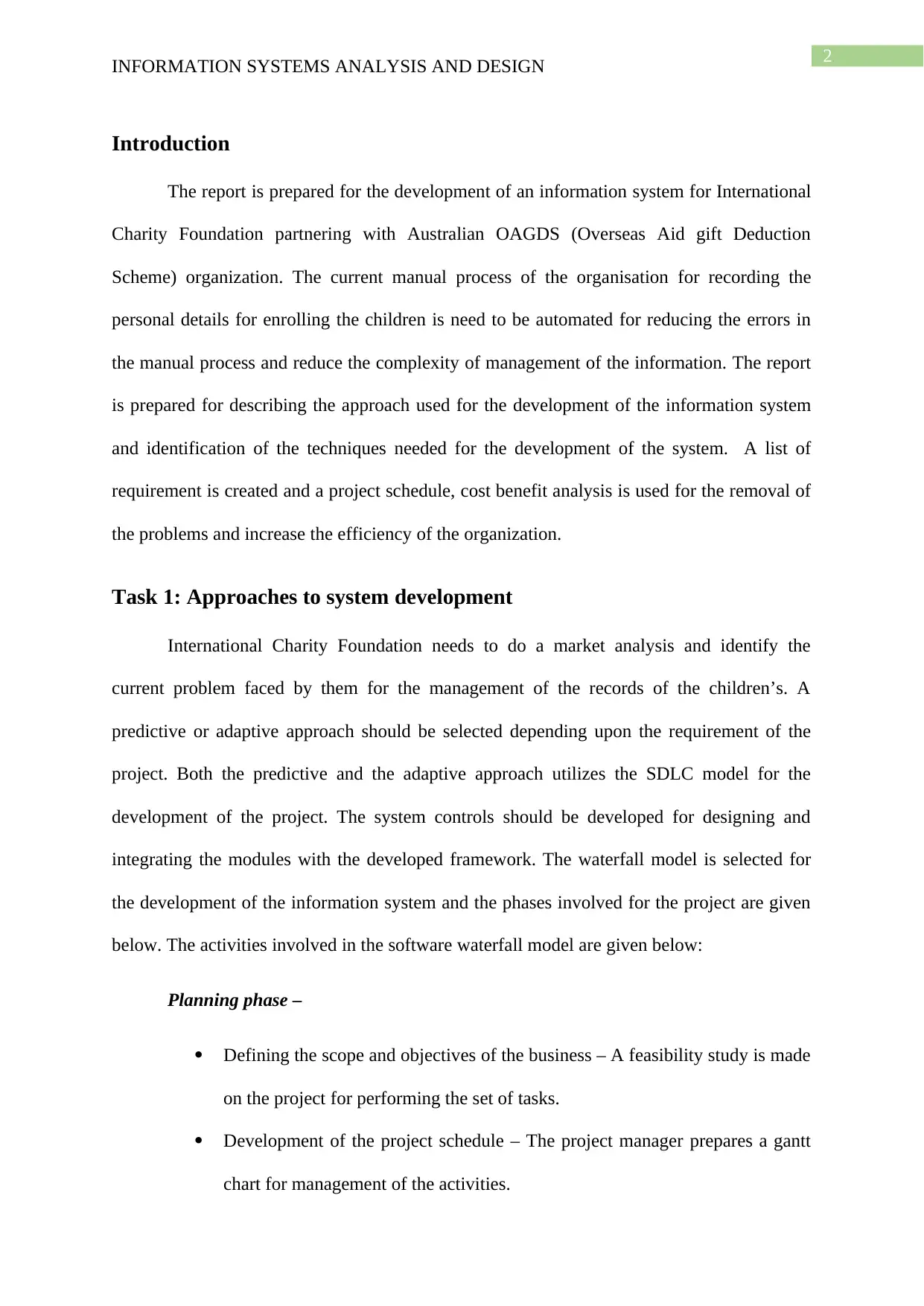
2
INFORMATION SYSTEMS ANALYSIS AND DESIGN
Introduction
The report is prepared for the development of an information system for International
Charity Foundation partnering with Australian OAGDS (Overseas Aid gift Deduction
Scheme) organization. The current manual process of the organisation for recording the
personal details for enrolling the children is need to be automated for reducing the errors in
the manual process and reduce the complexity of management of the information. The report
is prepared for describing the approach used for the development of the information system
and identification of the techniques needed for the development of the system. A list of
requirement is created and a project schedule, cost benefit analysis is used for the removal of
the problems and increase the efficiency of the organization.
Task 1: Approaches to system development
International Charity Foundation needs to do a market analysis and identify the
current problem faced by them for the management of the records of the children’s. A
predictive or adaptive approach should be selected depending upon the requirement of the
project. Both the predictive and the adaptive approach utilizes the SDLC model for the
development of the project. The system controls should be developed for designing and
integrating the modules with the developed framework. The waterfall model is selected for
the development of the information system and the phases involved for the project are given
below. The activities involved in the software waterfall model are given below:
Planning phase –
Defining the scope and objectives of the business – A feasibility study is made
on the project for performing the set of tasks.
Development of the project schedule – The project manager prepares a gantt
chart for management of the activities.
INFORMATION SYSTEMS ANALYSIS AND DESIGN
Introduction
The report is prepared for the development of an information system for International
Charity Foundation partnering with Australian OAGDS (Overseas Aid gift Deduction
Scheme) organization. The current manual process of the organisation for recording the
personal details for enrolling the children is need to be automated for reducing the errors in
the manual process and reduce the complexity of management of the information. The report
is prepared for describing the approach used for the development of the information system
and identification of the techniques needed for the development of the system. A list of
requirement is created and a project schedule, cost benefit analysis is used for the removal of
the problems and increase the efficiency of the organization.
Task 1: Approaches to system development
International Charity Foundation needs to do a market analysis and identify the
current problem faced by them for the management of the records of the children’s. A
predictive or adaptive approach should be selected depending upon the requirement of the
project. Both the predictive and the adaptive approach utilizes the SDLC model for the
development of the project. The system controls should be developed for designing and
integrating the modules with the developed framework. The waterfall model is selected for
the development of the information system and the phases involved for the project are given
below. The activities involved in the software waterfall model are given below:
Planning phase –
Defining the scope and objectives of the business – A feasibility study is made
on the project for performing the set of tasks.
Development of the project schedule – The project manager prepares a gantt
chart for management of the activities.
⊘ This is a preview!⊘
Do you want full access?
Subscribe today to unlock all pages.

Trusted by 1+ million students worldwide
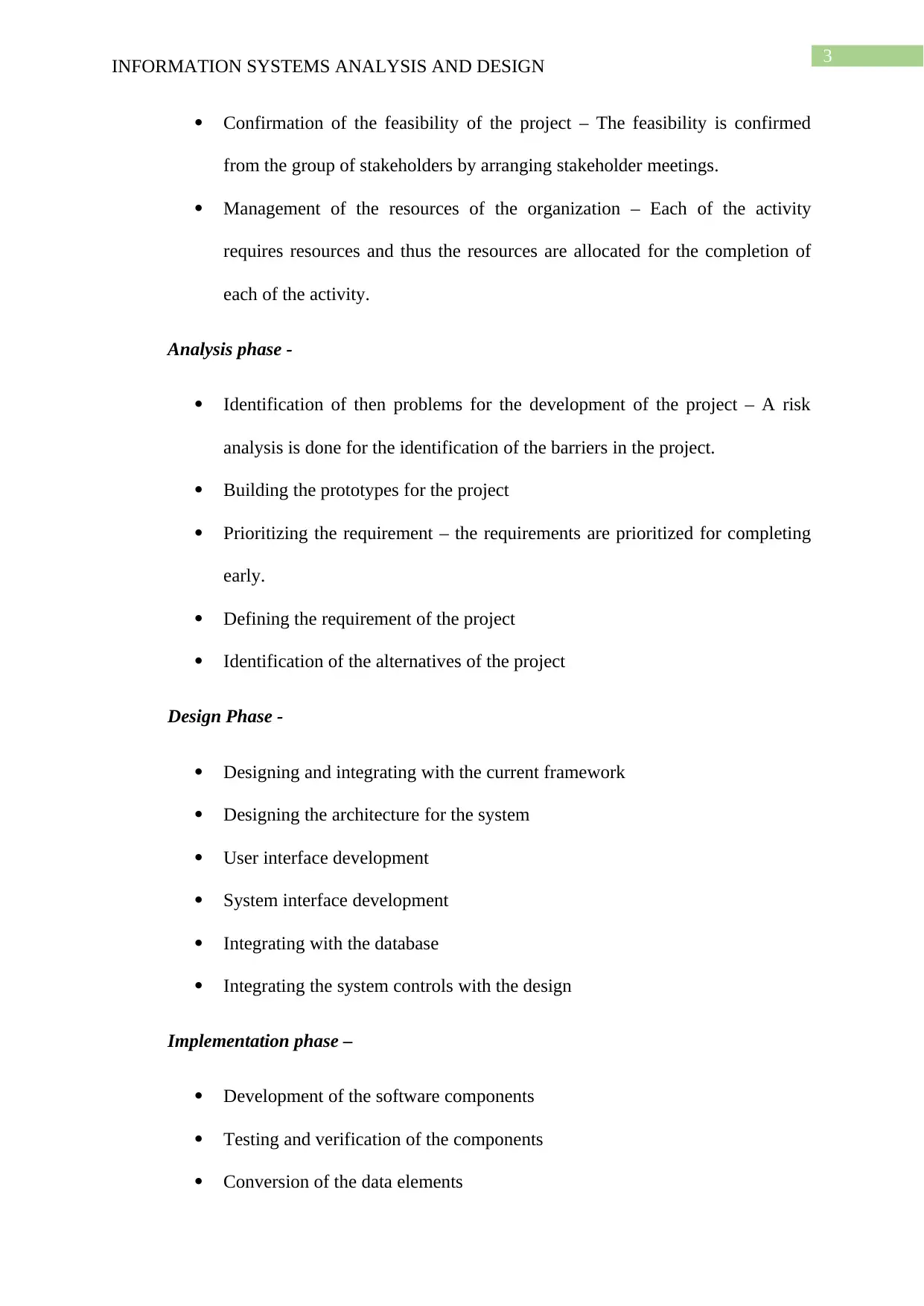
3
INFORMATION SYSTEMS ANALYSIS AND DESIGN
Confirmation of the feasibility of the project – The feasibility is confirmed
from the group of stakeholders by arranging stakeholder meetings.
Management of the resources of the organization – Each of the activity
requires resources and thus the resources are allocated for the completion of
each of the activity.
Analysis phase -
Identification of then problems for the development of the project – A risk
analysis is done for the identification of the barriers in the project.
Building the prototypes for the project
Prioritizing the requirement – the requirements are prioritized for completing
early.
Defining the requirement of the project
Identification of the alternatives of the project
Design Phase -
Designing and integrating with the current framework
Designing the architecture for the system
User interface development
System interface development
Integrating with the database
Integrating the system controls with the design
Implementation phase –
Development of the software components
Testing and verification of the components
Conversion of the data elements
INFORMATION SYSTEMS ANALYSIS AND DESIGN
Confirmation of the feasibility of the project – The feasibility is confirmed
from the group of stakeholders by arranging stakeholder meetings.
Management of the resources of the organization – Each of the activity
requires resources and thus the resources are allocated for the completion of
each of the activity.
Analysis phase -
Identification of then problems for the development of the project – A risk
analysis is done for the identification of the barriers in the project.
Building the prototypes for the project
Prioritizing the requirement – the requirements are prioritized for completing
early.
Defining the requirement of the project
Identification of the alternatives of the project
Design Phase -
Designing and integrating with the current framework
Designing the architecture for the system
User interface development
System interface development
Integrating with the database
Integrating the system controls with the design
Implementation phase –
Development of the software components
Testing and verification of the components
Conversion of the data elements
Paraphrase This Document
Need a fresh take? Get an instant paraphrase of this document with our AI Paraphraser
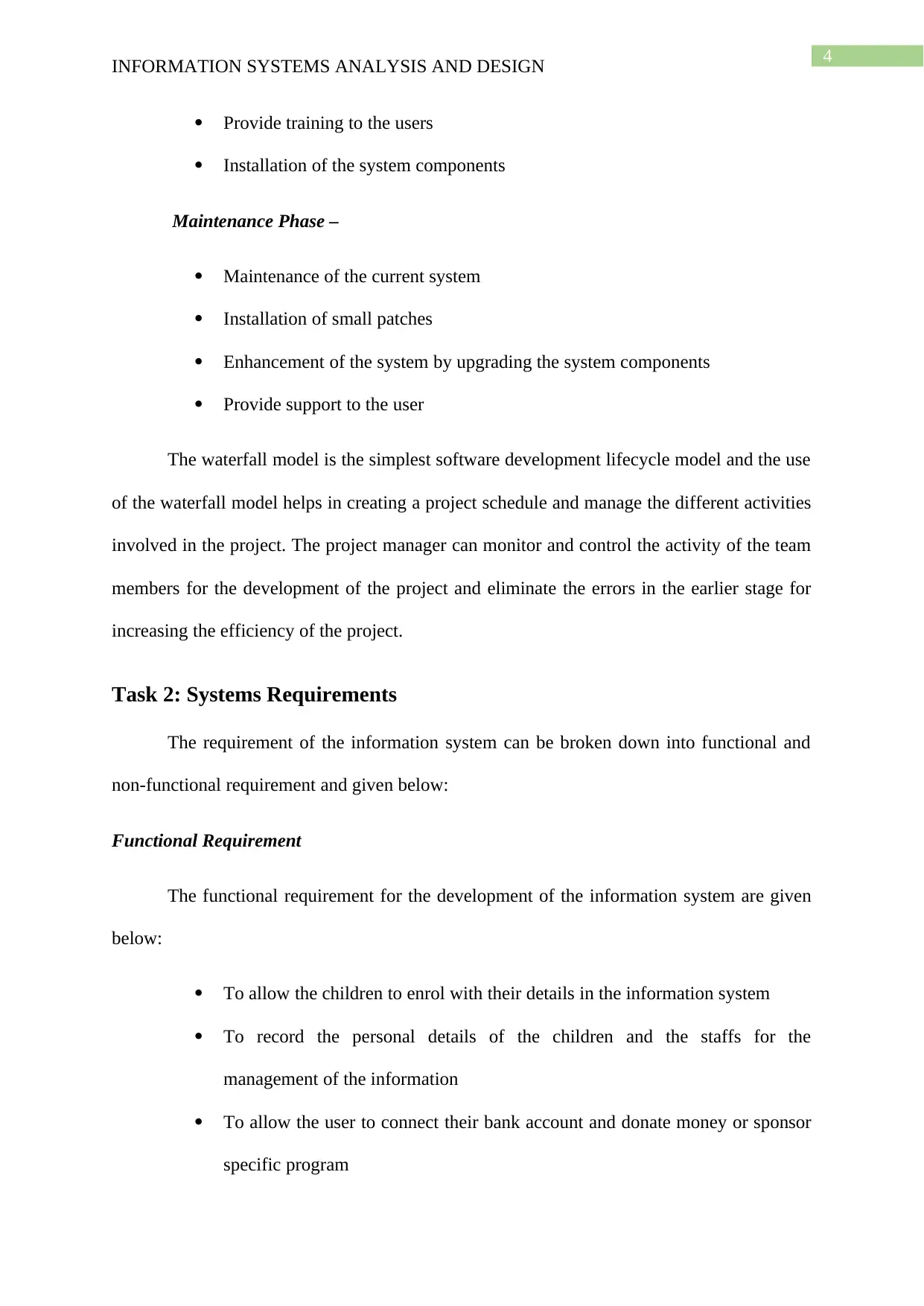
4
INFORMATION SYSTEMS ANALYSIS AND DESIGN
Provide training to the users
Installation of the system components
Maintenance Phase –
Maintenance of the current system
Installation of small patches
Enhancement of the system by upgrading the system components
Provide support to the user
The waterfall model is the simplest software development lifecycle model and the use
of the waterfall model helps in creating a project schedule and manage the different activities
involved in the project. The project manager can monitor and control the activity of the team
members for the development of the project and eliminate the errors in the earlier stage for
increasing the efficiency of the project.
Task 2: Systems Requirements
The requirement of the information system can be broken down into functional and
non-functional requirement and given below:
Functional Requirement
The functional requirement for the development of the information system are given
below:
To allow the children to enrol with their details in the information system
To record the personal details of the children and the staffs for the
management of the information
To allow the user to connect their bank account and donate money or sponsor
specific program
INFORMATION SYSTEMS ANALYSIS AND DESIGN
Provide training to the users
Installation of the system components
Maintenance Phase –
Maintenance of the current system
Installation of small patches
Enhancement of the system by upgrading the system components
Provide support to the user
The waterfall model is the simplest software development lifecycle model and the use
of the waterfall model helps in creating a project schedule and manage the different activities
involved in the project. The project manager can monitor and control the activity of the team
members for the development of the project and eliminate the errors in the earlier stage for
increasing the efficiency of the project.
Task 2: Systems Requirements
The requirement of the information system can be broken down into functional and
non-functional requirement and given below:
Functional Requirement
The functional requirement for the development of the information system are given
below:
To allow the children to enrol with their details in the information system
To record the personal details of the children and the staffs for the
management of the information
To allow the user to connect their bank account and donate money or sponsor
specific program
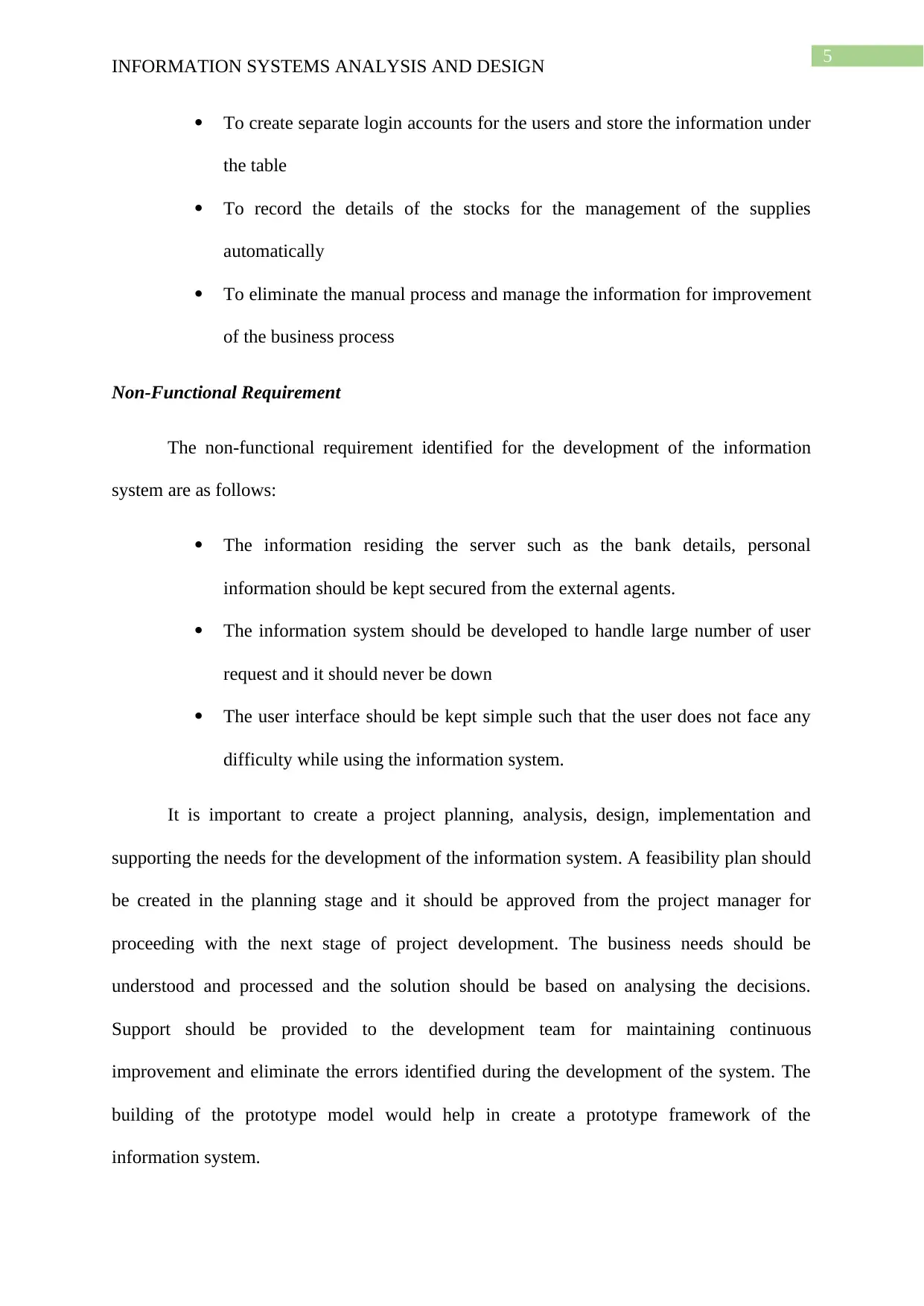
5
INFORMATION SYSTEMS ANALYSIS AND DESIGN
To create separate login accounts for the users and store the information under
the table
To record the details of the stocks for the management of the supplies
automatically
To eliminate the manual process and manage the information for improvement
of the business process
Non-Functional Requirement
The non-functional requirement identified for the development of the information
system are as follows:
The information residing the server such as the bank details, personal
information should be kept secured from the external agents.
The information system should be developed to handle large number of user
request and it should never be down
The user interface should be kept simple such that the user does not face any
difficulty while using the information system.
It is important to create a project planning, analysis, design, implementation and
supporting the needs for the development of the information system. A feasibility plan should
be created in the planning stage and it should be approved from the project manager for
proceeding with the next stage of project development. The business needs should be
understood and processed and the solution should be based on analysing the decisions.
Support should be provided to the development team for maintaining continuous
improvement and eliminate the errors identified during the development of the system. The
building of the prototype model would help in create a prototype framework of the
information system.
INFORMATION SYSTEMS ANALYSIS AND DESIGN
To create separate login accounts for the users and store the information under
the table
To record the details of the stocks for the management of the supplies
automatically
To eliminate the manual process and manage the information for improvement
of the business process
Non-Functional Requirement
The non-functional requirement identified for the development of the information
system are as follows:
The information residing the server such as the bank details, personal
information should be kept secured from the external agents.
The information system should be developed to handle large number of user
request and it should never be down
The user interface should be kept simple such that the user does not face any
difficulty while using the information system.
It is important to create a project planning, analysis, design, implementation and
supporting the needs for the development of the information system. A feasibility plan should
be created in the planning stage and it should be approved from the project manager for
proceeding with the next stage of project development. The business needs should be
understood and processed and the solution should be based on analysing the decisions.
Support should be provided to the development team for maintaining continuous
improvement and eliminate the errors identified during the development of the system. The
building of the prototype model would help in create a prototype framework of the
information system.
⊘ This is a preview!⊘
Do you want full access?
Subscribe today to unlock all pages.

Trusted by 1+ million students worldwide
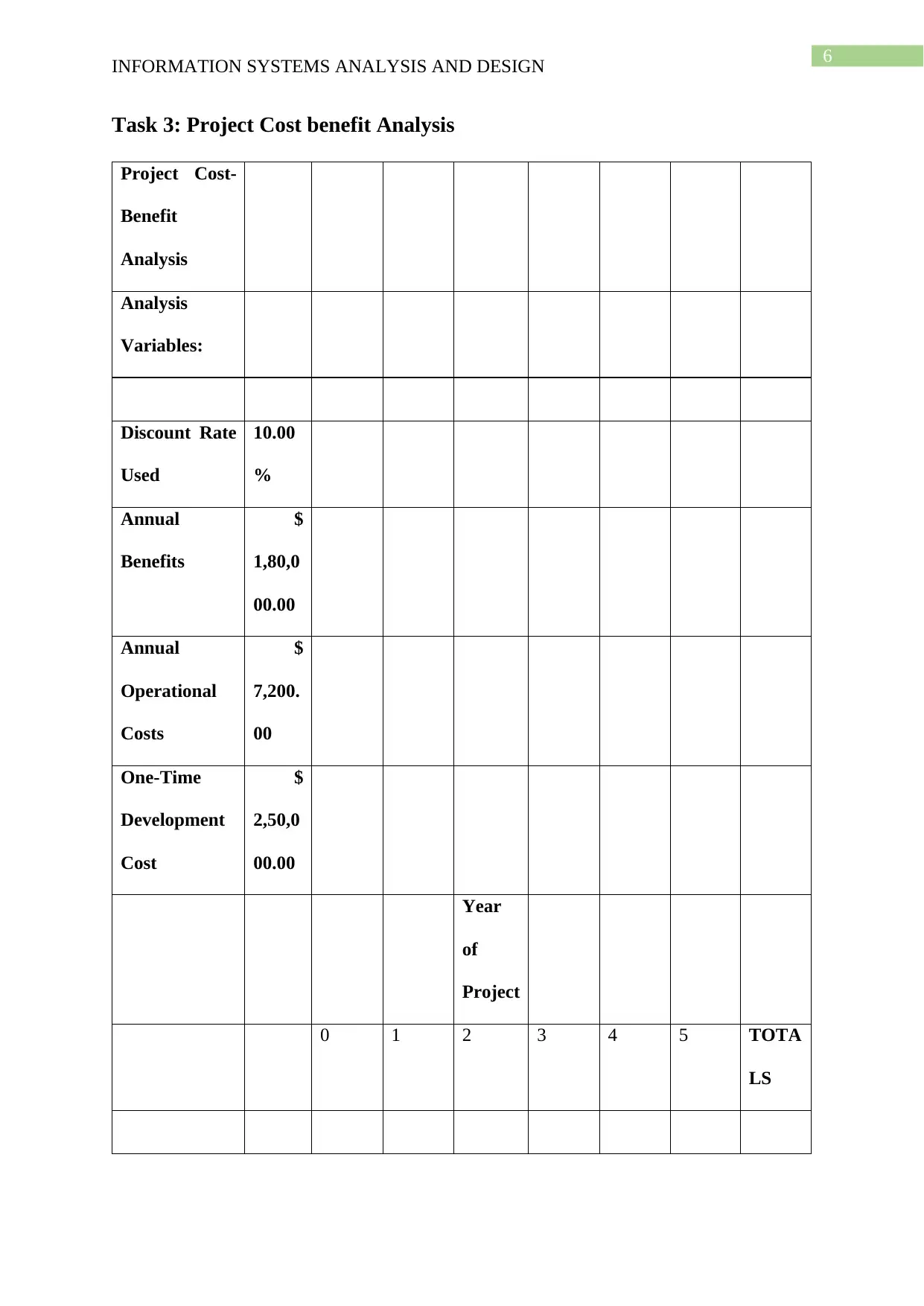
6
INFORMATION SYSTEMS ANALYSIS AND DESIGN
Task 3: Project Cost benefit Analysis
Project Cost-
Benefit
Analysis
Analysis
Variables:
Discount Rate
Used
10.00
%
Annual
Benefits
$
1,80,0
00.00
Annual
Operational
Costs
$
7,200.
00
One-Time
Development
Cost
$
2,50,0
00.00
Year
of
Project
0 1 2 3 4 5 TOTA
LS
INFORMATION SYSTEMS ANALYSIS AND DESIGN
Task 3: Project Cost benefit Analysis
Project Cost-
Benefit
Analysis
Analysis
Variables:
Discount Rate
Used
10.00
%
Annual
Benefits
$
1,80,0
00.00
Annual
Operational
Costs
$
7,200.
00
One-Time
Development
Cost
$
2,50,0
00.00
Year
of
Project
0 1 2 3 4 5 TOTA
LS
Paraphrase This Document
Need a fresh take? Get an instant paraphrase of this document with our AI Paraphraser
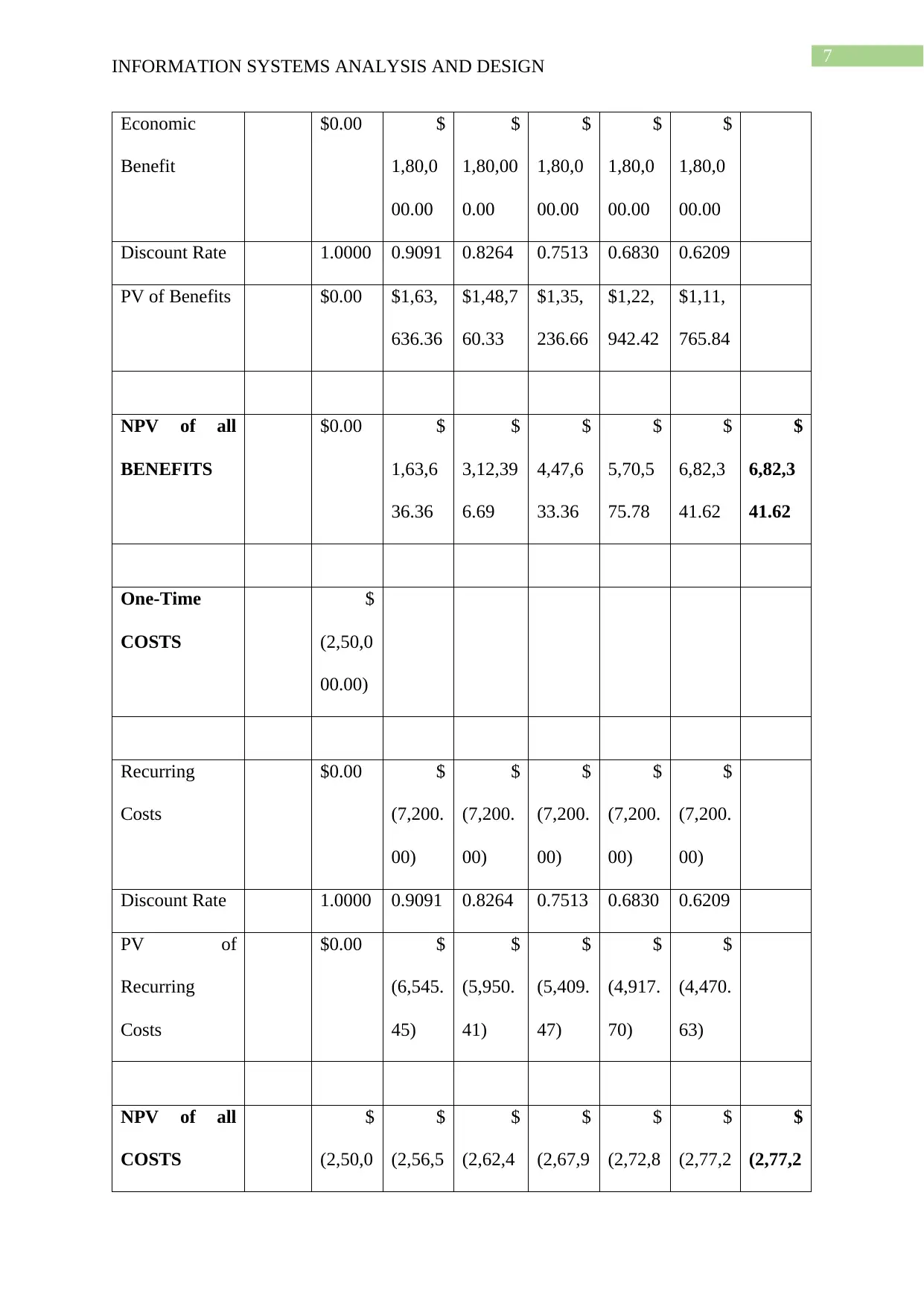
7
INFORMATION SYSTEMS ANALYSIS AND DESIGN
Economic
Benefit
$0.00 $
1,80,0
00.00
$
1,80,00
0.00
$
1,80,0
00.00
$
1,80,0
00.00
$
1,80,0
00.00
Discount Rate 1.0000 0.9091 0.8264 0.7513 0.6830 0.6209
PV of Benefits $0.00 $1,63,
636.36
$1,48,7
60.33
$1,35,
236.66
$1,22,
942.42
$1,11,
765.84
NPV of all
BENEFITS
$0.00 $
1,63,6
36.36
$
3,12,39
6.69
$
4,47,6
33.36
$
5,70,5
75.78
$
6,82,3
41.62
$
6,82,3
41.62
One-Time
COSTS
$
(2,50,0
00.00)
Recurring
Costs
$0.00 $
(7,200.
00)
$
(7,200.
00)
$
(7,200.
00)
$
(7,200.
00)
$
(7,200.
00)
Discount Rate 1.0000 0.9091 0.8264 0.7513 0.6830 0.6209
PV of
Recurring
Costs
$0.00 $
(6,545.
45)
$
(5,950.
41)
$
(5,409.
47)
$
(4,917.
70)
$
(4,470.
63)
NPV of all
COSTS
$
(2,50,0
$
(2,56,5
$
(2,62,4
$
(2,67,9
$
(2,72,8
$
(2,77,2
$
(2,77,2
INFORMATION SYSTEMS ANALYSIS AND DESIGN
Economic
Benefit
$0.00 $
1,80,0
00.00
$
1,80,00
0.00
$
1,80,0
00.00
$
1,80,0
00.00
$
1,80,0
00.00
Discount Rate 1.0000 0.9091 0.8264 0.7513 0.6830 0.6209
PV of Benefits $0.00 $1,63,
636.36
$1,48,7
60.33
$1,35,
236.66
$1,22,
942.42
$1,11,
765.84
NPV of all
BENEFITS
$0.00 $
1,63,6
36.36
$
3,12,39
6.69
$
4,47,6
33.36
$
5,70,5
75.78
$
6,82,3
41.62
$
6,82,3
41.62
One-Time
COSTS
$
(2,50,0
00.00)
Recurring
Costs
$0.00 $
(7,200.
00)
$
(7,200.
00)
$
(7,200.
00)
$
(7,200.
00)
$
(7,200.
00)
Discount Rate 1.0000 0.9091 0.8264 0.7513 0.6830 0.6209
PV of
Recurring
Costs
$0.00 $
(6,545.
45)
$
(5,950.
41)
$
(5,409.
47)
$
(4,917.
70)
$
(4,470.
63)
NPV of all
COSTS
$
(2,50,0
$
(2,56,5
$
(2,62,4
$
(2,67,9
$
(2,72,8
$
(2,77,2
$
(2,77,2
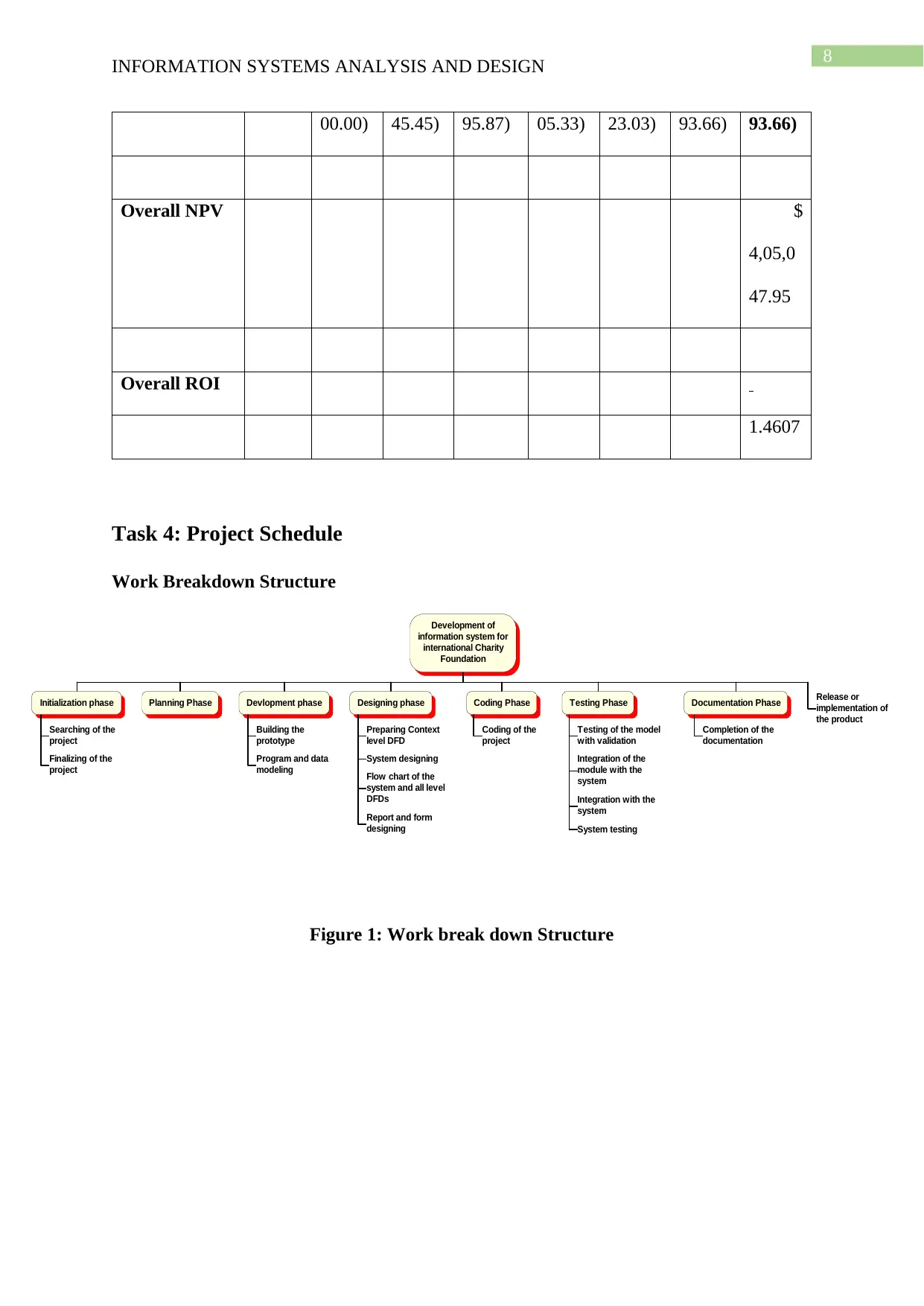
8
INFORMATION SYSTEMS ANALYSIS AND DESIGN
00.00) 45.45) 95.87) 05.33) 23.03) 93.66) 93.66)
Overall NPV $
4,05,0
47.95
Overall ROI
1.4607
Task 4: Project Schedule
Work Breakdown Structure
Figure 1: Work break down Structure
Development of
information system for
international Charity
Foundation
Initialization phase
Searching of the
project
Finalizing of the
project
Planning Phase Devlopment phase
Building the
prototype
Program and data
modeling
Designing phase
Preparing Context
level DFD
System designing
Flow chart of the
system and all level
DFDs
Report and form
designing
Coding Phase
Coding of the
project
Testing Phase
Testing of the model
with validation
Integration of the
module with the
system
Integration with the
system
System testing
Documentation Phase
Completion of the
documentation
Release or
implementation of
the product
INFORMATION SYSTEMS ANALYSIS AND DESIGN
00.00) 45.45) 95.87) 05.33) 23.03) 93.66) 93.66)
Overall NPV $
4,05,0
47.95
Overall ROI
1.4607
Task 4: Project Schedule
Work Breakdown Structure
Figure 1: Work break down Structure
Development of
information system for
international Charity
Foundation
Initialization phase
Searching of the
project
Finalizing of the
project
Planning Phase Devlopment phase
Building the
prototype
Program and data
modeling
Designing phase
Preparing Context
level DFD
System designing
Flow chart of the
system and all level
DFDs
Report and form
designing
Coding Phase
Coding of the
project
Testing Phase
Testing of the model
with validation
Integration of the
module with the
system
Integration with the
system
System testing
Documentation Phase
Completion of the
documentation
Release or
implementation of
the product
⊘ This is a preview!⊘
Do you want full access?
Subscribe today to unlock all pages.

Trusted by 1+ million students worldwide
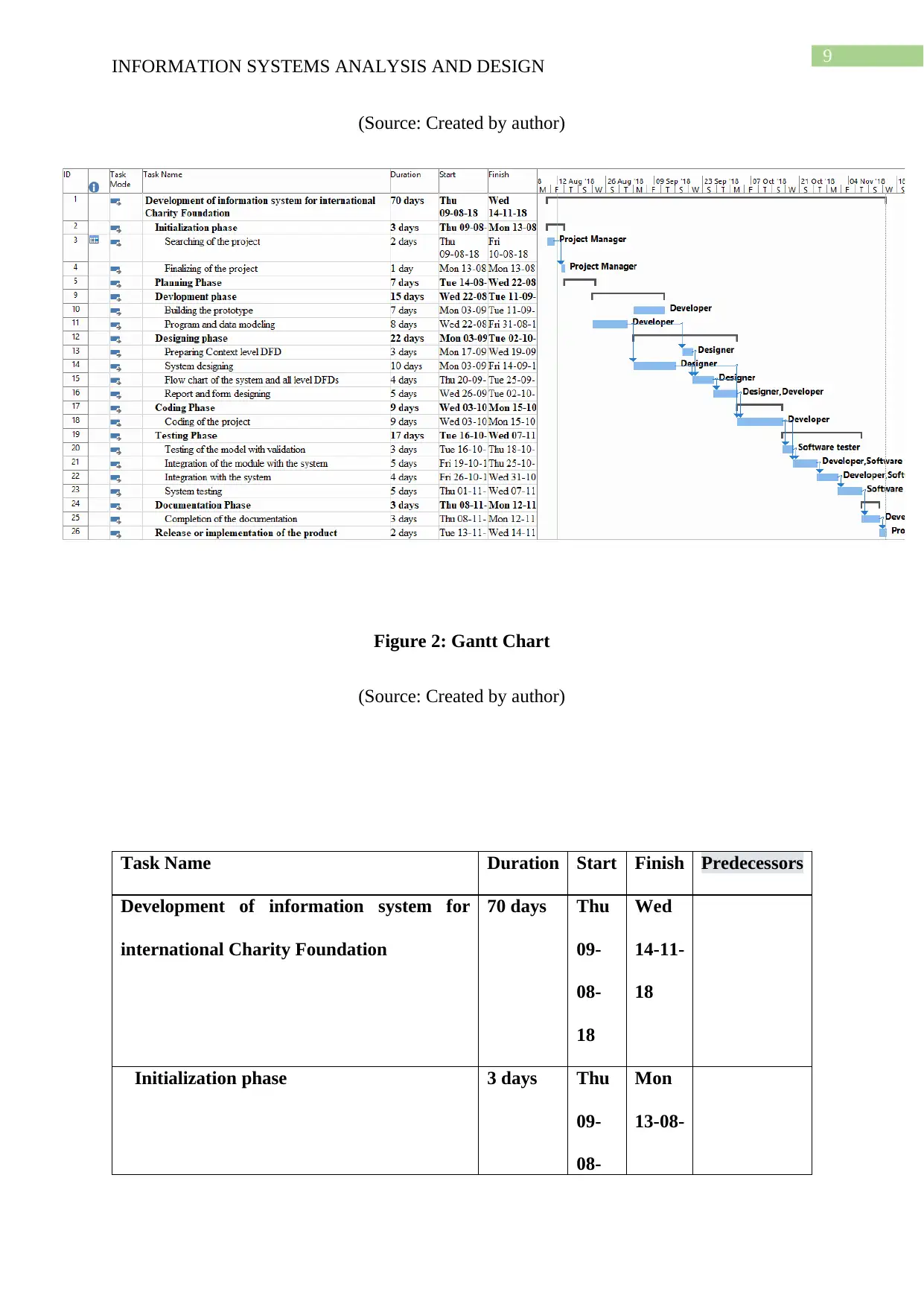
9
INFORMATION SYSTEMS ANALYSIS AND DESIGN
(Source: Created by author)
Figure 2: Gantt Chart
(Source: Created by author)
Task Name Duration Start Finish Predecessors
Development of information system for
international Charity Foundation
70 days Thu
09-
08-
18
Wed
14-11-
18
Initialization phase 3 days Thu
09-
08-
Mon
13-08-
INFORMATION SYSTEMS ANALYSIS AND DESIGN
(Source: Created by author)
Figure 2: Gantt Chart
(Source: Created by author)
Task Name Duration Start Finish Predecessors
Development of information system for
international Charity Foundation
70 days Thu
09-
08-
18
Wed
14-11-
18
Initialization phase 3 days Thu
09-
08-
Mon
13-08-
Paraphrase This Document
Need a fresh take? Get an instant paraphrase of this document with our AI Paraphraser
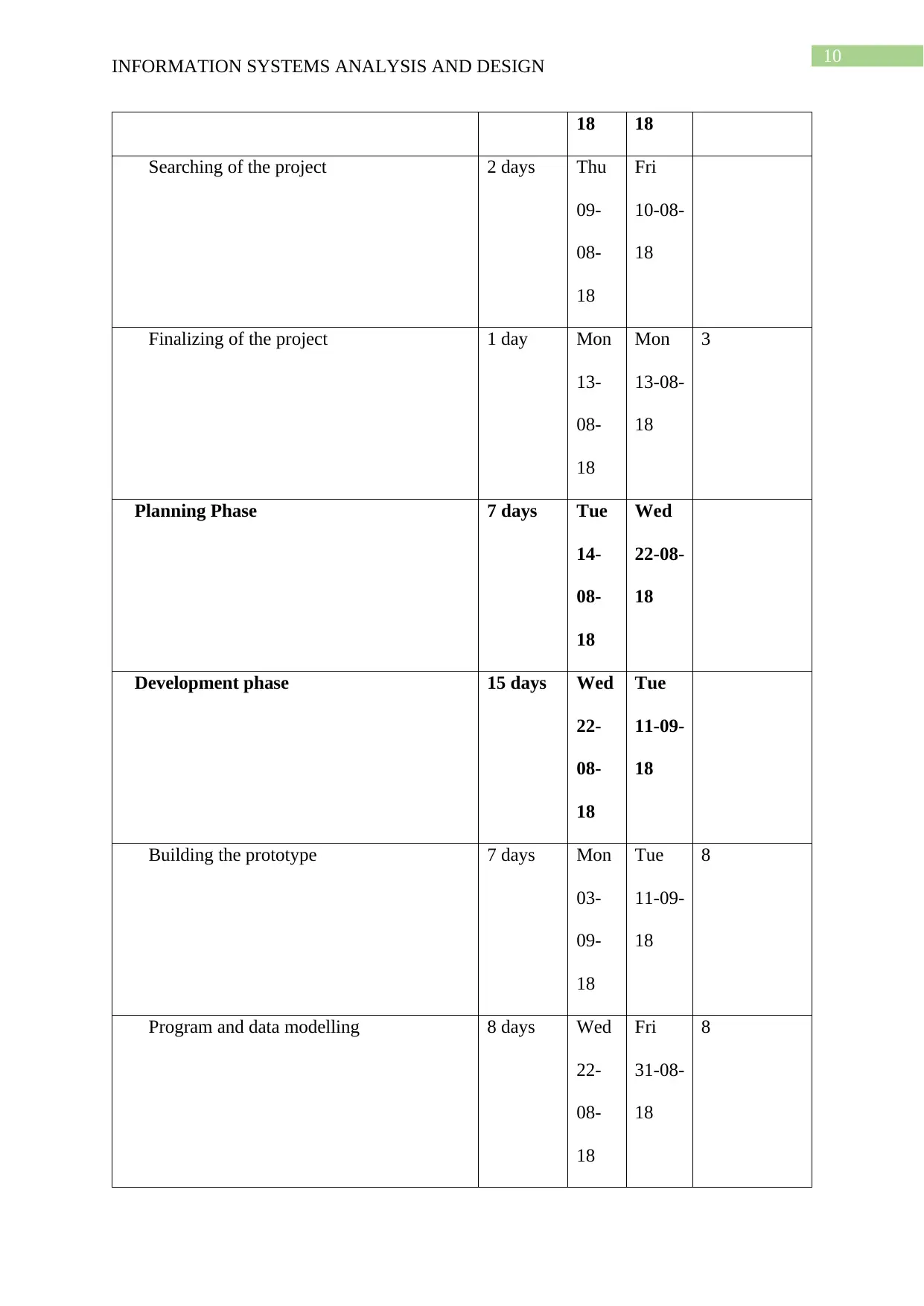
10
INFORMATION SYSTEMS ANALYSIS AND DESIGN
18 18
Searching of the project 2 days Thu
09-
08-
18
Fri
10-08-
18
Finalizing of the project 1 day Mon
13-
08-
18
Mon
13-08-
18
3
Planning Phase 7 days Tue
14-
08-
18
Wed
22-08-
18
Development phase 15 days Wed
22-
08-
18
Tue
11-09-
18
Building the prototype 7 days Mon
03-
09-
18
Tue
11-09-
18
8
Program and data modelling 8 days Wed
22-
08-
18
Fri
31-08-
18
8
INFORMATION SYSTEMS ANALYSIS AND DESIGN
18 18
Searching of the project 2 days Thu
09-
08-
18
Fri
10-08-
18
Finalizing of the project 1 day Mon
13-
08-
18
Mon
13-08-
18
3
Planning Phase 7 days Tue
14-
08-
18
Wed
22-08-
18
Development phase 15 days Wed
22-
08-
18
Tue
11-09-
18
Building the prototype 7 days Mon
03-
09-
18
Tue
11-09-
18
8
Program and data modelling 8 days Wed
22-
08-
18
Fri
31-08-
18
8
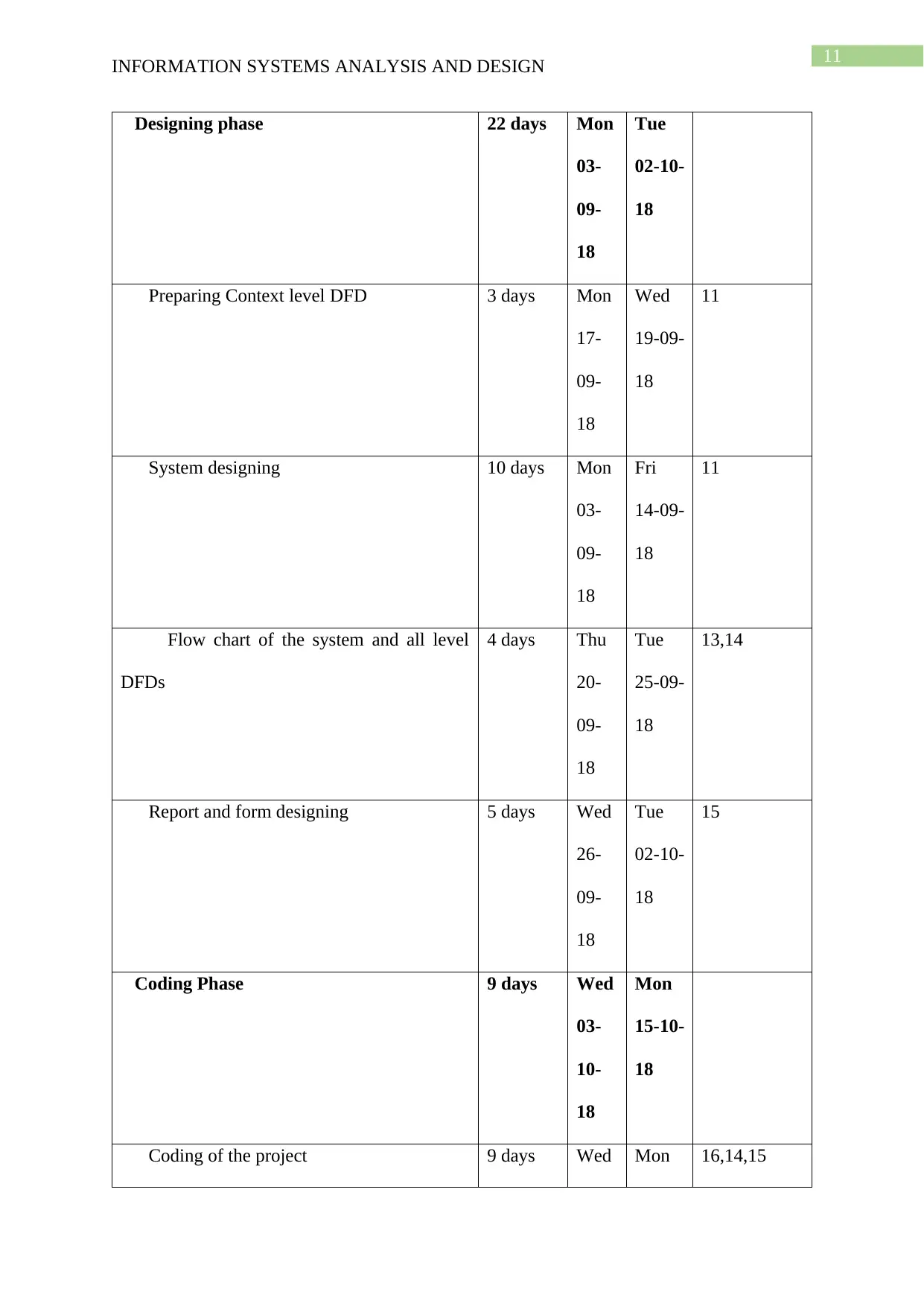
11
INFORMATION SYSTEMS ANALYSIS AND DESIGN
Designing phase 22 days Mon
03-
09-
18
Tue
02-10-
18
Preparing Context level DFD 3 days Mon
17-
09-
18
Wed
19-09-
18
11
System designing 10 days Mon
03-
09-
18
Fri
14-09-
18
11
Flow chart of the system and all level
DFDs
4 days Thu
20-
09-
18
Tue
25-09-
18
13,14
Report and form designing 5 days Wed
26-
09-
18
Tue
02-10-
18
15
Coding Phase 9 days Wed
03-
10-
18
Mon
15-10-
18
Coding of the project 9 days Wed Mon 16,14,15
INFORMATION SYSTEMS ANALYSIS AND DESIGN
Designing phase 22 days Mon
03-
09-
18
Tue
02-10-
18
Preparing Context level DFD 3 days Mon
17-
09-
18
Wed
19-09-
18
11
System designing 10 days Mon
03-
09-
18
Fri
14-09-
18
11
Flow chart of the system and all level
DFDs
4 days Thu
20-
09-
18
Tue
25-09-
18
13,14
Report and form designing 5 days Wed
26-
09-
18
Tue
02-10-
18
15
Coding Phase 9 days Wed
03-
10-
18
Mon
15-10-
18
Coding of the project 9 days Wed Mon 16,14,15
⊘ This is a preview!⊘
Do you want full access?
Subscribe today to unlock all pages.

Trusted by 1+ million students worldwide
1 out of 18
Related Documents
Your All-in-One AI-Powered Toolkit for Academic Success.
+13062052269
info@desklib.com
Available 24*7 on WhatsApp / Email
![[object Object]](/_next/static/media/star-bottom.7253800d.svg)
Unlock your academic potential
Copyright © 2020–2025 A2Z Services. All Rights Reserved. Developed and managed by ZUCOL.




